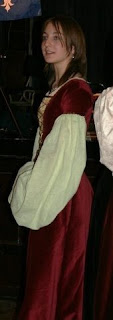'Surely there must be something at the V&A Museum?', ask my parents. Well in the world of post-1500 AD, yes. However if there were evidence of early corsets pre-1500 AD stashed somewhere in the V&A, my bones have a funny feeling many historical re-enactor women would be rabbiting on about it by now. There is little doubt from the multitude of images of women with unnatural figures that the corset probably started in its infancy as early as the 1400's at least. As i shall demonstrate below:
Medieval silk weaver
There is very little way this neckline and waistline could be achieved without the aid of a bodice.
The Romans de la Rose (Romance of the Rose)
The lady dancing in the bottom left hand corner was inspiration for a noble lady's dress a couple of years ago. I struggled to find affordable rose pink velvet for it, so i substituted it with a gorgeously light-weight red velvet (see below). If you look carefully at the ladies above however they all have a poise that is difficult to attain without further support, for to dance with good balance requires the upper body to lean forward slightly with the weight on the toes, rather than backwards with the weight on the heels. Their stomachs/hips appear to extend forwards distinctly as they stand in an odd posture, though whether this is a desired attribute of fertility with broad hips shown through artistic licence, the use of petticoats or the effect of a bodice it is not clear.
I've seen other front lacing dresses with very flat, taught stomachers; flatter than i can achieve without a firm frame underneath. There is something that has not been quite right about my dress, so i think it needs a little boost...
Corsets of some shape or form have been around for thousands of years. According to my research by the 1500's this would have been referred to as a 'pair of bodies', mostly at this point worn not with the aim of displaying a slim waist, but to keep an even, flat-fronted, round shape. The below website seemed the most informative on this matter:
http://www.elizabethancostume.net/corsets/history.html#pictures
It is my suspicion that corsets, just like the suggestion that Henry VIII's rather protruding codpiece fashion being the result of having to hide syphilis and the development of mending scarred skin tissue to casual cosmetic surgery, are rooted in a desire to correct medical problems. When tailored clothes came into being between 1300-1500, so did the exposure of physical human imperfection become highlighted.
When a mother is expected to bring up marriageable daughters who have grace, eloquence and poise, the choice of nagging them not to slouch is not attractive. Why not stick them in a bodice so graceful posture becomes habit and their spines grow straight? If you have given birth to one or more children, you figure may not be what it once was, so why not give it a little boost? If you have a diet that does not encourage the ideal figure, why not give it a bit of a leg-up?
So how were they made? Most assumptions i've heard are that buckram and some kind of glue, for it has been documented. But that's not to say that it was the only way. This first method has complications, for the buckram they used then i have heard is different from the 'buckram' we know now; the glue could be messy to make and use. So in this knowledge i gave up the hunt for an alternative solution for a few years... Until i found this recently:
http://www.festiveattyre.com/research/cording/cord.html
Yup. The alternative possibility is Hemp Cording. Which would back up my 'seam strength' theory. It would be slightly softer to the body form and truer to early paintings than the Tudor shape using buckram. For those like the silk worker (at the top), a bodice would require all materials they could get their hands on to create the desired finish. Since my medieval roles now stretch from merchant and armourer's wife to nobility, i must strive to craft a bodice that could have been created by middle classes with limited materials, yet look like a piece worthy of a Knight's Lady. My Mum said 'why bother putting so much effort into something no-one will see?'. My response is that unless it is tried, it will never be unravelled - this is an adventure of self-satisfaction and experimental fiddlings...
My initial ideas have been to use two layers of cotton or linen for the cording, using either rolled scraps or string. For additional shape some twisted wire inserted in major cord seams. On the back, a simple lining, on the front a wooden busk placed down the centre between the cording, covered with silk or fine leather (which my mum suggested) to hide the bumps. These developed, for if i found a busk too uncomfortable then the plan B was to try couching wire of experimental thicknesses in an opposite direction to the cording on the back. So if cording were vertical, wire would be horizontal and vice versa.
Food for Thought:
Triptych of the Family Moreel, 1484
Portrait of a Young Woman by Domenico Ghirlandaio, 1485
Giovanna Tornabuoni, ca.1488
The Lady with an Ermine - Cecilia Gallerani, 1489
Margaret of Austria, 1490
Part 2 to come, with drawings and deliberation on the shape of the pattern i could use....








No comments:
Post a Comment